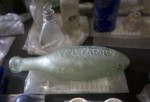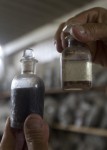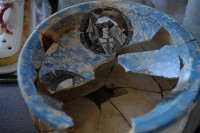 Archaeologists excavating the site of a future subway extension in Rio de Janeiro have unearthed more than 200,000 artifacts from the 17th to 19th centuries. Many of them are in pristine condition, even fragile pieces like glass bottles and ceramic containers, and they have an illustrious provenance. There was a slaughterhouse on the site between 1853 and 1881, but before that archaeologists believe it was a garbage dump for the nearby imperial palace.
Archaeologists excavating the site of a future subway extension in Rio de Janeiro have unearthed more than 200,000 artifacts from the 17th to 19th centuries. Many of them are in pristine condition, even fragile pieces like glass bottles and ceramic containers, and they have an illustrious provenance. There was a slaughterhouse on the site between 1853 and 1881, but before that archaeologists believe it was a garbage dump for the nearby imperial palace.
 Garbage is often a rich source of archaeological treasure, and this landfill is an outstanding example of that having preserved decades, even centuries of material history of the imperial family and other area residents. It’s a massive combined record of the mundane and rarefied, mundane because they are consumer products like toothbrushes and water bottles, rarefied because what would be an everyday drug store purchase for us peasants was a bespoke, finely crafted and doubtless very expensive import for the emperors of Brazil.
Garbage is often a rich source of archaeological treasure, and this landfill is an outstanding example of that having preserved decades, even centuries of material history of the imperial family and other area residents. It’s a massive combined record of the mundane and rarefied, mundane because they are consumer products like toothbrushes and water bottles, rarefied because what would be an everyday drug store purchase for us peasants was a bespoke, finely crafted and doubtless very expensive import for the emperors of Brazil.
The ivory toothbrush thought to have belonged to Dom Pedro II, who ruled over Brazil from 1831-1889, has turned brown with age. Its boar bristles are long gone, but the inscription remains legible: “His Majesty the Emperor of Brazil.” A round white porcelain pot emblazoned with “to the Queen of Portugal Maria of Saboia” is thought to have contained mint-flavored tooth paste made specially for the queen by a chemist with offices in London and Paris.
The site has also yielded dozens of intact glass and ceramic bottles thought to have once contained water imported from Europe for the imperial family. Six sealed bottles still contain unidentified liquids that the team plans to send to a laboratory for analysis. Dozens of coins and pipes were also found, along with a golden ring and a tie tack.
 Archaeologists believe the artifacts survived in such exceptional condition because the area was swampy and waterlogged. The wet conditions provided cushioning and protection for breakable objects like bottles and jars, keeping many of them intact without even a crack.
Archaeologists believe the artifacts survived in such exceptional condition because the area was swampy and waterlogged. The wet conditions provided cushioning and protection for breakable objects like bottles and jars, keeping many of them intact without even a crack.
Excavations have been suspended for the time being for the construction of the new subway tunnels which are part of the city’s preparations for the 2016 Olympics. All the dig trenches have been covered with multiple layers to protect them from damage during construction and to clearly mark the sites. When the tunnels and stations are complete at the end of 2015,  excavations will resume. Lead archaeologist Claudio Prado de Mello believes they’ve only scratched the surface, that there may be as many as 800,000 artifacts on this site.
excavations will resume. Lead archaeologist Claudio Prado de Mello believes they’ve only scratched the surface, that there may be as many as 800,000 artifacts on this site.
The team of more than 30 archaeologists and historians will spend the next three years working on the vast store of artifacts they’ve unearthed. The finds will be cleaned and catalogued, the broken pieces and fragments will be collected and puzzled together. All the laboratory work is being underwritten by the company that won the subway building contract.